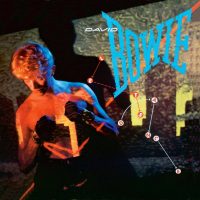 Recorded: December 1982, January 1983
Recorded: December 1982, January 1983
Producers: David Bowie, Nile Rodgers
Released: 14 April 1983
Personnel
David Bowie: vocals
Carmine Rojas, Bernard Edwards: bass guitar
Nile Rodgers, Stevie Ray Vaughan: guitar
Rob Sabino: keyboards
Mac Gollehon: trumpet
Robert Arron, Stan Harrison: tenor saxophone, flute
Steve Elson: baritone saxophone, flute
Omar Hakim, Tony Thompson: drums
Sammy Figueroa: percussion
Frank Simms, George Simms, David Spinner: backing vocals
Tracklisting
- ‘Modern Love’
- ‘China Girl’
- ‘Let’s Dance’
- ‘Without You’
- ‘Ricochet’
- ‘Criminal World’
- ‘Cat People (Putting Out Fire)’
- ‘Shake It’
David Bowie’s 15th studio album, Let’s Dance was his biggest seller. Co-produced by Chic’s Nile Rodgers, it contained the hit singles ‘Let’s Dance’, ‘China Girl’ and ‘Modern Love’.
It’s kind of a mixed bag, really. And – not for any elitist reason – (laughter) there are no synthesizers on it. I really wanted that same positive optimistic rock ‘n’ roll big band sound that was very impressionistic for me back when. It’s got a hard cut, very high on treble – it sears through.
Musician magazine, May 1983
Bowie first met Rodgers at 5am at the Continental club in Manhattan. He drove there, accompanied by the singer Billy Idol, in his 1977 Maserati Bora.
After Billy and I walked in and my pupils adjusted to the club’s dim light, I noticed something strange enough to catch my eye, even in this den of weirdness: David Bowie was sitting at the back bar, all by himself, soaking up the bizarre scene. Bowie, who’d spent the last decade dressing as an androgynous alien, a harlequin, and an albino ‘duke’, seemed almost mundane in this environment. Even for someone as cool as David Bowie, it was probably a strange brew.After saying hello to some friends, Billy finally noticed David. I’d been clocking the rock legend all along but pretended to be cool about it. Meanwhile, Billy, never what you might call a wallflower, shouted, ‘Fuckin’ ‘ell, that’s David Booooowiiiieeeee!‘ and started heading in David’s direction, his progress only slightly slowed by a violent spasm of vomiting. Billy wiped his mouth on his sleeve and marched on.
Le Freak
Bowie was sober, sipping orange juice, and surveying the scene. Rodgers asked the bartender, Scotty Taylor, to introduce him to the singer, but Taylor declined, leaving Rodgers to make his own introduction. The two musicians quickly bonded, and stayed talking until after 5am.
We wound up talking all night about all sorts of music. I don’t remember anyone ever bothering us; we were like old friends sitting on a couch in someone’s living room. The wide-ranging, reference heavy, autodidactic rap made me feel like I was back in the mix of the beatniks, hippies, and jazzers of my youth. At some point I must have given him my phone number, but I don’t remember doing so.
Le Freak
Shortly after the encounter, Bowie telephoned Rodgers’ home in Westport, Connecticut. The house was being renovated at the time, and the general contractor repeatedly answered the phone, then hung up, believing Bowie to be a prank caller. Eventually Rodgers got wind of this and, thankfully, Bowie called again.
They arranged to meet one afternoon at Bemelmans Bar at the Carlyle Hotel, on 35 East 76th Street, Manhattan. Rodgers wore a suit, keen to give a more professional impression than he had at the Continental.
But David didn’t look like himself either, or at least what I imagined he would look like. He wasn’t wearing makeup or his iconic hat. As it turned out, we were sitting at the bar maybe 15 feet from one another, both ordering drinks, but neither of us recognized the other. I even called his office at one point and asked when he was arriving. They told me he had been there at least half an hour, so I went back inside and looked for him. Eventually, I spotted the most David Bowie-esque guy there and re-introduced myself. We both started cracking up. Plus, my girlfriend and her friends had arrived earlier because they wanted to get a glimpse of David Bowie! They were sitting there watching us like, ‘Is this some kind of rock and roll ritual? That you have to act like you don’t know one another?The experience at Bemelmans Bar meant a lot to me emotionally. You see, it wouldn’t have been racist or bizarre for him to assume the only black guy at Bemelsmans was me, even if I looked different. At that time, most people would have thought I was Nile Rodgers even if I didn’t look like Nile Rodgers. It wouldn’t have made sense to most people to see multiple black guys at Bemelmans in the middle of the afternoon. But David being the incredible forward thinking man he was assumed I was just another black gentleman.
Loving The Alien (1983-1988) book

